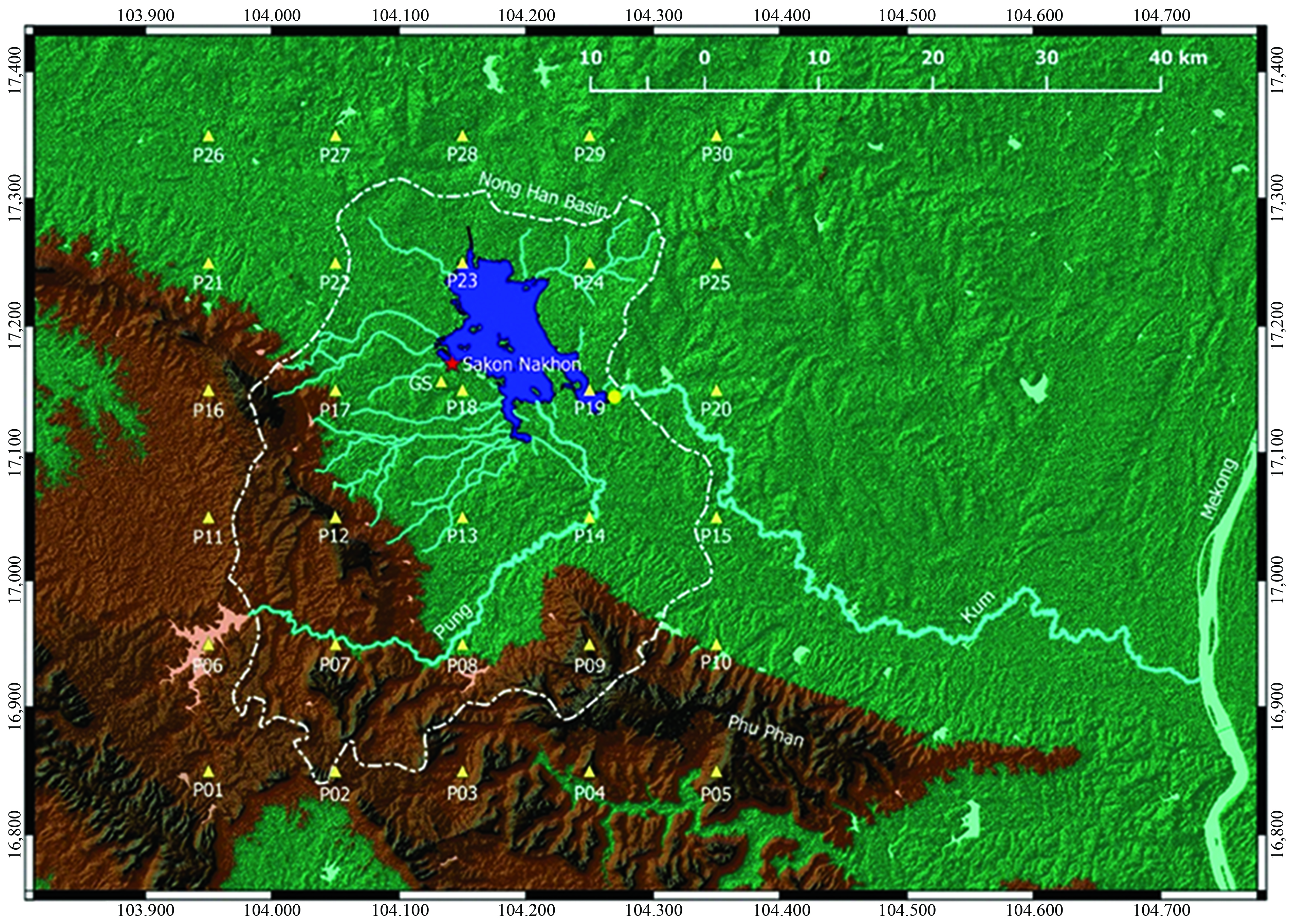Early Warning of Lake Level Fluctuations using Global Precipitation Measurement Data: A Case Study Nong Han Lake
Main Article Content
Abstract
This research investigated the possibility of using Global Precipitation Measurement Data (GPM) for early warning of Nong Han level fluctuations. The simple correlations between the input variables (such as the current lake level, the outflow rate, the evaporation rate, the daily precipitation, and the GPM data) and a target variable (the early-warning index of Nong Han lake level-fluctuations) were examined. Moreover, the early-warning model of level fluctuations hazard was developed, using GMDH-type neural networks. The results indicated that the correlations between of Nong Han level fluctuations with the current lake level and the outflow rate are high; and, the interrelationship between evaporation rate, the daily precipitation, and the GPM data is medium-low. The model evaluation, which uses blind data show the high ability of model with 90.5 % accuracy. The GPM data, thus, represents a helpful tool for early warning of lake level fluctuations.
Article Details
References
[2] Lehner, B., Döll, P., Alcamo, J., Henrichs, T., and Kaspar, F. (2006). Estimating the Impact of Global Change on Flood and Drought Risks in Europe: A Continental, Integrated Analysis. Climatic Change. Vol. 75, Issue 3, pp. 273-299. DOI: 10.1007/s10584-006-6338-4
[3] Wiering, M. and Winnubst, M. (2017). The Conception of Public Interest in Dutch Flood Risk Management: Untouchable or Transforming?. Environmental Science & Policy. Vol. 73, pp. 12-19. DOI: 10.1016/j.envsci.2017.03.002
[4] Zhang, Q., Zhang, J., and Wang, C. (2017). Risk Assessment of Drought Disaster in Typical Area of Corn Cultivation in China. Theoretical and Applied Climatology. Vol. 128, Issue 3-4, pp. 533-540. DOI: 10.1007/s00704-015-1723-4
[5] Reynard, N. S., Kay, A. L., Anderson, M., Donovan, B., and Duckworth, C. (2017). The Evolution of Climate Change Guidance for Fluvial Flood Risk Management in England. Physical Geography. Vol. 41, Issue 2, pp. 222-237. DOI: 10.1177/0309133317702566
[6] Singkran, N. (2017). Flood Risk Management in Thailand: Shifting from a Passive to a Progressive Paradigm. International Journal of Disaster Risk Reduction. Vol. 25, pp. 92-100. DOI: 10.1016/j.ijdrr.2017.08.003
[7] Stratford, C., Brewin, P., Acreman, M., and Mountford, O. (2015). A Simple Model to Quantify the Potential Trade-Off Between Water Level Management for Ecological Benefit and Flood Risk. Ecohydrology & Hydrobiology. Vol. 15, Issue 3, pp. 150-159. DOI: 10.1016/j.ecohyd.2015.06.002
[8] Sun, G., Zheng, H., Huang, Y., and Li, C. (2016). Parameter Inversion and Deformation Mechanism of Sanmendong Landslide in the Three Gorges Reservoir Region Under the Combined Effect of Reservoir Water Level Fluctuation and Rainfall. Engineering Geology. Vol. 205, pp. 133-145. DOI: 10.1016/j.enggeo.2015.10.014
[9] Zhao, Q., Liu, S., Deng, L., Dong, S., and Wang, C. (2014). Soil Degradation Associated with Water-Level Fluctuations in the Manwan Reservoir, Lancang River Basin. CATENA. Vol. 113, pp. 226-235. DOI: 10.1016/j.catena.2013.08.007
[10] Mettrop, I. S., Rutte, M. D., Kooijman, A. M., and Lamers, L. P. M. (2015). The Ecological Effects of Water Level Fluctuation and Phosphate Enrichment in Mesotrophic Peatlands are Strongly Mediated by Soil Chemistry. Ecological Engineering. Vol. 85, pp. 226-236. DOI: 10.1016/j.ecoleng.2015.09.077
[11] Qian, K., Liu, X., and Chen, Y. (2016). Effects of Water Level Fluctuation on Phytoplankton Succession in Poyang Lake, China - A Five Year Study. Ecohydrology & Hydrobiology. Vol. 16, pp. 175-184. DOI: DOI: 10.1016/j.ecohyd.2016.08.001
[12] Wang, P., Zhang, Q., Xu, Y.-S., and Yu, F. H. (2016). Effects of Water Level Fluctuation on the Growth of Submerged Macrophyte Communities. Flora. Vol. 223, pp. 83-89. DOI: 10.1016/j.flora.2016.05.005
[13] Grabas, G. P. and Rokitnicki-Wojcik, D. (2015). Characterizing Daily Water-Level Fluctuation Intensity and Water Quality Relationships with Plant Communities in Lake Ontario Coastal wetlands. Journal of Great Lakes Research. Vol. 41, Issue 1, pp. 136-144. DOI: 10.1016/j.jglr.2014.12.019
[14] Menouer, M. A. and Moussaoui, A. (2016). Effects of Consecutive Water Level Fluctuations and Harvesting on Predator-Prey Interactions. Chaos, Solitons & Fractals. Vol. 91, pp. 434-442. DOI: 10.1016/j.chaos.2016.07.001
[15] Yadav, B. and Eliza, K. (2017). A Hybrid Wavelet-Support Vector Machine Model for Prediction of Lake Water Level Fluctuations Using Hydro-Meteorological Data. Measurement. Vol. 103, pp. 294-301. DOI: 10.1016/j.measurement.2017.03.003
[16] Tapiador, F. J., Turk, F. J., Petersen, W., Hou, A. Y., García-Ortega, E., Machado, L. A. T., Angelis, C. F., Salio, P., Kidd, C., Huffman, G. J., and de Castro, M. (2012). Global Precipitation Measurement: Methods, Datasets and Applications. Atmospheric Research. Vol. 104, pp. 70-97
[17] Tapiador, F. J., Navarro, A., Levizzani, V., García-Ortega, E., Huffman, G. J., Kidd, C., Kucera, P. A., Kummerow, C. D., Masunaga, H., Petersen, W.A., Roca, R., Sánchez, J.-L., Tao, W. -K., and Turk, F. J. (2017). Global Precipitation Measurements for Validating Climate Models. Atmospheric Research. Vol. 197, pp. 1-20. DOI: 10.1016/j.atmosres.2017.06.021
[18] Wang, Z., Zhong, R., Lai, C., and Chen, J. (2017). Evaluation of the GPM IMERG Satellite-based Precipitation Products and the Hydrological Utility. Atmospheric Research. Vol. 196, pp. 151-163. DOI: 10.1016/j.atmosres.2017.06.018
[19] Casella, D., Panegrossi, G., Sanò, P., Marra, A. C., Dietrich, S., Johnson, B. T., and Kulie, M. S. (2017). Evaluation of the GPM-DPR Snowfall Detection Capability: Comparison with CloudSat-CPR. Atmospheric Research. Vol. 197, pp. 64-75. DOI: 10.1016/j.atmosres.2017.06.018
[20] Prakash, S., Mitra, A. K., Pai, D. S., and AghaKouchak, A. (2016). From TRMM to GPM: How well can heavy rainfall be detected from space?. Advances in Water Resources. Vol. 88, pp. 1-7. DOI: 10.1016/j.advwatres.2015.11.008
[21] Siswanto, van der Schrier, G., Jan van Oldenborgh, G., van den Hurk, B., Aldrian, E., Swarinoto, Y., Sulistya, W., and Eka Sakya, A. (2017). A Very Unusual Precipitation Event Associated with the 2015 Floods in Jakarta: An Analysis of the Meteorological Factors. Weather and Climate Extremes. Vol. 16, pp. 23-28. DOI: 10.1016/j.wace.2017.03.003
[22] Case, J. L. (2016). From Drought to Flooding in Less Than a Week Over South Carolina. Results in Physics. Vol. 6, pp. 1183-1184. DOI: 10.1016/j.rinp.2016.11.012

